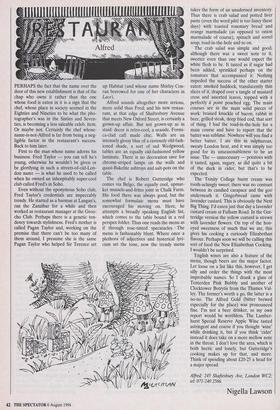PERHAPS the fact that the name over the door of
this new establishment is that of the chap who owns it rather than the one whose food is eaten in it is a sign that the chef, whose place in society seemed in the Eighties and Nineties to be what the pho- tographer's was in the Sixties and Seven- ties, is becoming a less saleable celeb. item. Or maybe not. Certainly the chef whose- name-is-not-Alfred is far from being a neg- ligible factor in the restaurant's success. Back to him later.
First to the man whose name adorns his business. Fred Taylor — you can tell he's young, otherwise he wouldn't be given or be glorifying in such a streets-of-old-Lon- don name — is what he used to be called when he owned an inhospitably super-cool club called Fred's in Soho.
Even without the eponymous Soho club, Fred Taylor's credentials are impeccably trendy. He started as a barman at Langan's, ran the Zanzibar for a while and then worked as restaurant manager at the Grou- cho Club. Perhaps there is a genetic ten- dency towards stylishness. Fred's mother is called Pagan Taylor and, working on the premise that there can't be too many of them around, I presume she is the same Pagan Taylor who helped Sir Terence set up Habitat (and whose name Shirley Con- ran borrowed for one of her characters in Lace).
Alfred sounds altogether more serious, more solid than Fred; and his new restau- rant, at that edge of Shaftesbury Avenue that meets New Oxford Street, is certainly a grown-up affair. But not grown-up as in staid: decor is retro-cool, a seaside, Formi- ca-clad caff made chic. Walls are an intensely glossy blue of a curiously old-fash- ioned shade, a sort of sad. Wedgwood; tables are an equally old-fashioned yellow laminate. There is no decoration save for chrome-striped lamps on the walls and quasi-Bakelite ashtrays and salt-pots on the table.
The chef is Robert Gutteridge who comes via Belgo, the equally cool, upmar- ket mussels-and-frites joint in Chalk Farm. His food there was always good, but the somewhat formulaic menu must have encouraged his moving on. Here, he attempts a broadly speaking English list, which comes to the table bound in a red perspex folder. Thus one reads the menu as if through rose-tinted specatacles. • The menu is fashionably blunt. Where once a plethora of adjectives and hysterical lyri- cism set the tone, now the trendy menu takes the form of an unadorned inventory. Thus there is crab salad and potted liver paste (even the word pate is too fancy these days) with toasted rosemary bread and orange marmalade (as opposed to onion marmalade of course), spinach and sorrel soup, toad-in-the-hole and so on.
The crab salad was simple and good, although there was a sweet note to it, sweeter even than one would expect the white flesh to be. It tasted as if sugar had been added, sprinkled perhaps on the tomatoes that accompanied it. Nothing impeded the success of the other starter eaten: smoked haddock, translucently thin slices of it, draped over a tangle of mustard cress and assorted leaves, topped with a perfectly a point poached egg. The main courses are in the main solid pieces of work: braised knuckle of bacon, rabbit in beer, grilled steak, deep fried cod, that sort of thing. I had the toad-in-the-hole for a main course and have to report that the batter was sublime. Nowhere will you find a better batter. I ate this in sulphurous, sweaty London heat, and it was simply too good for its unseasonableness to be an issue. The — unnecessary — potatoes with it tasted, again, sugary, as did quite a bit of the duck in cider, but that's to be expected.
The Trinity College burnt cream was tooth-achingly sweet; there was no contrast between its candied carapace and the goo underneath it. Gingerbread came with lavender custard. This is obviously the Next Big Thing. I'd eaten just that day a lavender custard cream at Fulham Road. In the Gut- teridge version the yellow custard is strewn with lavender flowers. On top of the hon- eyed sweetness of much that we ate, this gives his cooking a curiously Elizabethan flavour. Perhaps soon we will be calling this sort of food the New Elizabethan Cooking. I wouldn't be surprised.
English wines are also a feature of the menu, though beers are the major factor. Let loose on a list like this, however, I get silly and order the things with the most improbable names. So I drank a glass of Tenterden Pink Bubbly and another of Clocktower Botrytis from the Thames Val- ley. The former's worth a go, the latter is a no-no. The Alfred Gold (bitter brewed especially for the place) was pronounced fine. I'm not a beer drinker, so my own report would be worthless. The Lamber- hurst Special Reserve Apple Wine tasted astringent and coarse if you thought 'wine' while drinking it, but if you think 'cider' instead it does take on a more mellow note in the throat. I don't love the area, which is both hectic and lonely, but Gutteridge's cooking makes up for that, and more. Think of spending about £20-25 a head for a major spread.
Alfred: 245 Shaftesbury Ave, London WC2; tel:• 071-240 2566.
Nigella Lawson


















































 Previous page
Previous page